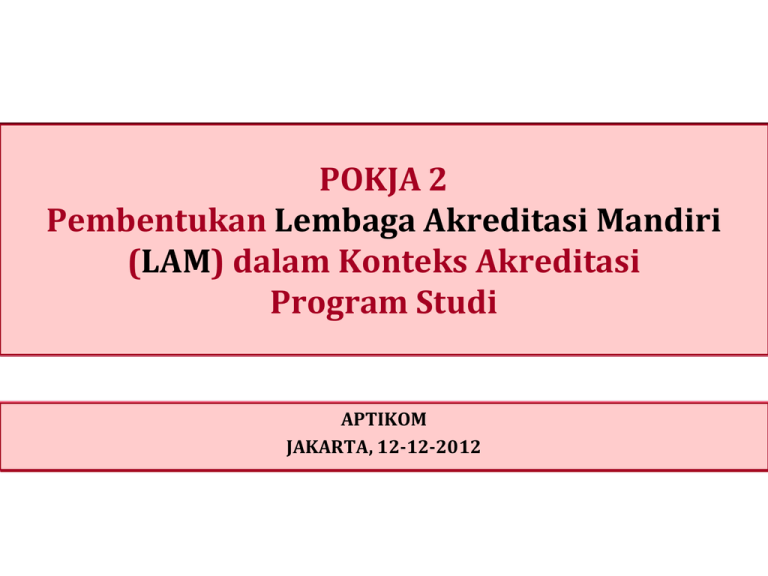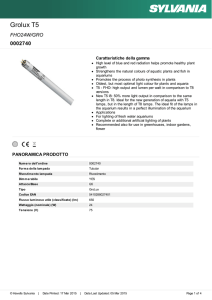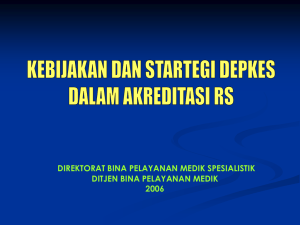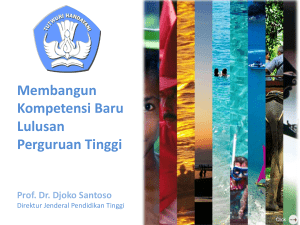POKJA 2
advertisement

POKJA 2 Pembentukan Lembaga Akreditasi Mandiri (LAM) dalam Konteks Akreditasi Program Studi APTIKOM JAKARTA, 12-12-2012 Kelompok Kerja LAM Bahasan 1 Profil PT Informatika/IKOM 2008 Bahasan 2 Data Agustus 2010 Bahasan 1 Bahasan 3 STANDAR AKREDITASI PROGRAM STUDI 1 VISI, MISI, TUJUAN DAN SASARNA, SERTA STRATEGI PENCAPAIA 2 TATAPAMONG, KEPEMIMPINAN, SISTEM PENGELOLAAN, DAN PENJAMINAN MUTU 3 MAHASISWA DAN LULUSAN 4 SUMBER DAYA MANUSIA 5 KURIKULUM, PEMBELAJARAN, DAN SUASANA AKADEMIK 6 PENDANAAN, SARANA, PRASARANA, DAN SISTEM INFORMASI 7 PENELITIAN, PELAYANAN/PENGABDIAN KEPADA MASYARAKAT, DAN KERJASAMA Bahasan 3 (cont’) • IEEE/ACM CSAB ABET (www.abet.org) • 2013-2014 Criteria for Accrediting Computing Programs Bahasan 3 (cont’) • The criteria for accreditation are in two sections – General Criteria – General Criteria apply to all programs accredited by an ABET commission. Each program accredited by an ABET commission must satisfy every Criterion that is in the General Criteria for that commission. – Program Criteria – The Program Criteria provide discipline-specific accreditation criteria. Programs must show that they satisfy all of the specific Program Criteria implied by the program title. Any overlapping requirements need be satisfied only once. Bahasan 3 (cont’) GENERAL CRITERIA • Criterion 1. Students – Student performance must be evaluated. Student progress must be monitored to foster success in attaining student outcomes, thereby enabling graduates to attain program educational objectives. Students must be advised regarding curriculum and career matters. – The program must have and enforce policies for accepting both new and transfer students, awarding appropriate academic credit for courses taken at other institutions, and awarding appropriate academic credit for work in lieu of courses taken at the institution. The program must have and enforce procedures to ensure and document that students who graduate meet all graduation requirements. Bahasan 3 (cont’) • Criterion 2. Program Educational Objectives – The program must have published program educational objectives that are consistent with the mission of the institution, the needs of the program’s various constituencies, and these criteria. There must be a documented, systematically utilized, and effective process, involving program constituencies, for the periodic review of these program educational objectives that ensures they remain consistent with the institutional mission, the program’s constituents’ needs, and these criteria. • Criterion 3. Student Outcomes – The program must have documented student outcomes that prepare graduates to attain the program educational objectives. There must be a documented and effective process for the periodic review and revision of these student outcomes. Bahasan 3 (cont’) • The program must enable students to attain, by the time of graduation: (a) An ability to apply knowledge of computing and mathematics appropriate to the discipline (b) An ability to analyze a problem, and identify and define the computing requirements appropriate to its solution (c) An ability to design, implement, and evaluate a computer-based system, process, component, or program to meet desired needs (d) An ability to function effectively on teams to accomplish a common goal (e) An understanding of professional, ethical, legal, security and social issues and responsibilities (f) An ability to communicate effectively with a range of audiences (g) An ability to analyze the local and global impact of computing on individuals, organizations, and society (h) Recognition of the need for and an ability to engage in continuing professional development (i) An ability to use current techniques, skills, and tools necessary for computing practice. Bahasan 3 (cont’) • Criterion 4. Continuous Improvement – The program must regularly use appropriate, documented processes for assessing and evaluating the extent to which the student outcomes are being attained. The results of these evaluations must be systematically utilized as input for the continuous improvement of the program. Other available information may also be used to assist in the continuous improvement of the program. • Criterion 5. Curriculum – The program’s requirements must be consistent with its program educational objectives and designed in such a way that each of the student outcomes can be attained. The curriculum must combine technical and professional requirements with general education requirements and electives to prepare students for a professional career and further study in the computing discipline associated with the program, and for functioning in modern society. The technical and professional requirements must include at least one year of upto-date coverage of fundamental and advanced topics in the computing discipline associated with the program. In addition, the program must include mathematics appropriate to the discipline beyond the pre-calculus level. For each course in the major required of all students, its content, expected performance criteria, and place in the overall program of study must be published. Bahasan 3 (cont’) • Criterion 6. Faculty – Each faculty member teaching in the program must have expertise and educational background consistent with the contributions to the program expected from the faculty member. The competence of faculty members must be demonstrated by such factors as education, professional credentials and certifications, professional experience, ongoing professional development, contributions to the discipline, teaching effectiveness, and communication skills. Collectively, the faculty must have the breadth and depth to cover all curricular areas of the program. – The faculty serving in the program must be of sufficient number to maintain continuity, stability, oversight, student interaction, and advising. The faculty must have sufficient responsibility and authority to improve the program through definition and revision of program educational objectives and student outcomes as well as through the implementation of a program of study that fosters the attainment of student outcomes. Bahasan 3 (cont’) • Criterion 7. Facilities – Classrooms, offices, laboratories, and associated equipment must be adequate to support attainment of the student outcomes and to provide an atmosphere conducive to learning. Modern tools, equipment, computing resources, and laboratories appropriate to the program must be available, accessible, and systematically maintained and upgraded to enable students to attain the student outcomes and to support program needs. Students must be provided appropriate guidance regarding the use of the tools, equipment, computing resources, and laboratories available to the program. – The library services and the computing and information infrastructure must be adequate to support the scholarly and professional activities of the students and faculty. Bahasan 3 (cont’) • Criterion 8. Institutional Support – Institutional support and leadership must be adequate to ensure the quality and continuity of the program. – Resources including institutional services, financial support, and staff (both administrative and technical) provided to the program must be adequate to meet program needs. The resources available to the program must be sufficient to attract, retain, and provide for the continued professional development of a qualified faculty. The resources available to the program must be – sufficient to acquire, maintain, and operate infrastructures, facilities and equipment appropriate for the program, and to provide an environment in which student outcomes can be attained. Bahasan 3 (cont’) • PROGRAM CRITERIA FOR COMPUTER SCIENCE AND SIMILARLY NAMED COMPUTING PROGRAMS • These program criteria apply to computing programs using computer science or similar terms in their titles. • 3. Student Outcomes – The program must enable students to attain, by the time of graduation: • (j) An ability to apply mathematical foundations, algorithmic principles, and computer science theory in the modeling and design of computer-based systems in a way that demonstrates comprehension of the tradeoffs involved in design choices. [CS] • (k) An ability to apply design and development principles in the construction of software systems of varying complexity. [CS] Bahasan 3 (cont’) • 5. Curriculum – Students must have the following amounts of course work or equivalent educational experience: • a. Computer science: One and one-third years that must include: 1. Coverage of the fundamentals of algorithms, data structures, software design, concepts of programming languages and computer organization and architecture. [CS] 2. An exposure to a variety of programming languages and systems. [CS] 3. Proficiency in at least one higher-level language. [CS] 4. Advanced course work that builds on the fundamental course work to provide depth. [CS] • b. One year of science and mathematics: 1. Mathematics: At least one half year that must include discrete mathematics. The additional mathematics might consist of courses in areas such as calculus, linear algebra, numerical methods, probability, statistics, number theory, geometry, or symbolic logic. [CS] 2. Science: A science component that develops an understanding of the scientific method and provides students with an opportunity to experience this mode of inquiry in courses for science or engineering majors that provide some exposure to laboratory work. [CS] • 6. Faculty – Some full time faculty members must have a Ph.D. in computer science. Bahasan 3 (cont’) • PROGRAM CRITERIA FOR INFORMATION SYSTEMS AND SIMILARLY NAMED COMPUTING PROGRAMS • These program criteria apply to computing programs using information systems or similar terms in their titles. • 3. Student Outcomes – The program must enable students to attain, by the time of graduation: • (j) An understanding of processes that support the delivery and management of information systems within a specific application environment. [IS] Bahasan 3 (cont’) • 5. Curriculum – Students must have course work or an equivalent educational experience that includes: – a. Information Systems: One year that must include: • 1. coverage of the fundamentals of a modern programming language, data management, networking and data communications, systems analysis and design and the role of Information Systems in organizations. [IS] • 2. advanced course work that builds on the fundamental course work to provide depth. [IS] – b. Information Systems Environment: One-half year of course work that must include varied topics that provide background in an environment in which the information systems will be applied professionally. [IS] – c. Quantitative analysis or methods including statistics. [IS] • 6. Faculty – Some full-time faculty, including those responsible for the IS curriculum development, must hold a terminal degree in information systems. Bahasan 3 (cont’) • PROGRAM CRITERIA FOR INFORMATION TECHNOLOGY AND SIMILARLY NAMED COMPUTING PROGRAMS • These program criteria apply to computing programs using information technology or similar terms in their titles. • 3. Student Outcomes – The program must enable students to attain, by the time of graduation: • (j) An ability to use and apply current technical concepts and practices in the core information technologies. [IT] • (k) An ability to identify and analyze user needs and take them into account in the selection, creation, evaluation and administration of computer-based systems. [IT] • (l) An ability to effectively integrate IT-based solutions into the user environment. [IT] • (m) An understanding of best practices and standards and their application. [IT] • (n) An ability to assist in the creation of an effective project plan. [IT] Bahasan 3 (cont’) • 5. Curriculum – Students must have course work or an equivalent educational experience that includes: • a. Coverage of the fundamentals of 1. the core information technologies of human computer interaction, information management, programming, networking, web systems and technologies. [IT] 2. information assurance and security. [IT] 3. system administration and maintenance. [IT] 4. system integration and architecture. [IT] • b. Advanced course work that builds on the fundamental course work to provide depth. [IT] Bahasan 4, 5 dan 6 Kelembagaan Akreditasi PT Saat Ini Fakta tentang BAN PT saat ini • Tugas, fungsi, dan tanggung jawab BAN PT ada dalam Permen 2005 • Sekretariat BAN PT adalah Balitbang, sehingga BAN PT bukanlah Satuan Kerja (Satker) problem • Konsekuensi bukan satuan kerja: • Masalah keuangan, report kinerja, dll langsung disampaikan kepada Balitbang, padahal seharusnya kan ke majelis problem o Berpengaruh buruk ke perencanaan : KEUANGAN dan KEPEGAWAIAN o Beberapa contoh efek buruk: pengajuan dana BAN PT ke dikti menjadi sulit karena yang bisa mengajukan anggaran adalah Satker; • Tahun 2011 BAN PT harus mengakreditasi 3100 prodi beban besar • Hubungan dengan DIKTI: o Hubungan kemitraan o Tugas dikti yang seharusnya adalah melaksanakan follow up hasil akreditasi, misalnya pembinaan terhadap PT atau Prodi dengan akreditasi C o Sejauh ini, Dikti juga memanfaatkan data BAN PT, misalnya untuk kepentingan pemeringkatan PT, PHKI, dll Profil Asesor Saat ini 1. Saat ini berjumlah 1900 orang, tetapi yang aktif 1200 orang 2. Asesor dapat diibaratkan sebagai “BAN luar” berkaitan langsung dengan PRODI 3. Terkadang ada asesor “nakal”, misalnya asesor yang dalam melakukan asesmen tidak mengikuti panduan, asesor yang bermain dengan uang, dst. 4. Asesor berasal dari kalangan dosen, tetapi untuk kasus-kasus terntentu, misalnya asesor untuk akademi kebidanan dapat merupakan seorang yang ditunjuk dari keorganisasian kebidanan. 5. Asesor berasal dari PS yang terakreditasi baik (A) dan diusakahan bergelar Doktor (untuk S1), sedangkan untuk Diploma tidak harus Doktor. 6. Banyak asesor yang terkena “halo effect”, yaitu membanding-bandingkan kondisi PS atau PT yang sedang di asesment dengan kondisi PS atau PT dimana asesor tersebut berasal atau pernah menempuh studi. 7. Dari validasi, dapat diketahui asesor mana yang perlu diberikan pelatihan kambali 8. Distribusi asal regional asesor yang tidak merata kebanyakan asesor berasal dari PT di Pulau Jawa karena memang di Pulau Jawa yang banyak memiliki akreditasi A. 9. Peta keahlian asesor sudah ada, hanya perlu dilakukan pemutahiran saja. Lembaga Akreditasi Mandiri (LAM) Dimungkinkan oleh perundang-undangan Didirikan oleh masyarakat atas izin menteri Aturan tentang spesifik LAM belum ada, termasuk yang mengatur tentang operasionalnya. Saat ini diperlukan LAM Profesi, LSM Vokasi, dan LAM Akademik LAM Regional??? isu standardisasi Untuk sekedar mendirikan LAM, bisa saja dibentuk oleh kementerian hukum dan HAM, tapi operasionalnya bagaimana? Sebuah usulan LAM dibentuk oleh menteri kemendikbud atas konfirmasi/ijin/rekomendasi BAN PT LAM yang sudah dirintis bekerjasama dengan asosiasi profesi saat ini adalah LAM Kesehatan, LAM Teknik (LAM profesi) MODEL YANG DAPAT DIKEMBANGKAN 1 Organisasi LPM-PT dan Badan Akreditasi Nasional Perguruan Tinggi KEMDIKBUD ASOSIASI PERGURUAN TINGGI (Majelis/Forum Rektor) ORGANISASI PROFESI/ KEILMUAN PEMBENTUKAN MUTU/ KELAYAKAN STANDAR MAJELIS BADAN AKREDITASI NASIONAL PERGURUAN TINGGI (BAN-PT) PEMBENTUKAN PELAKSANA AKREDITASI INSTITUSI PERGURUAN TINGGI PERGURUAN TINGGI A PERGURUAN TINGGI B PERGURUAN TINGGI C dst. PELAKSANA AKREDITASI PROGRAM STUDI UMUM (ilmiah &Profesi) PROGRAM STUDI P PROGRAM STUDI Q PROGRAM STUDI R dst. LAM Profesi & KeIimuan PELAKSANA AKREDITASI PROGRAM STUDI PROFESI (Ilmiah / Profesi) PS PROFESI X PS PROFESI Y PS PROFESI Z dst. Dalam frames berikut ini diberikan lima alternatif model organisasi lembaga penjaminan mutu pendidikan tinggi (LPM-PT)/BAB-LT, termasuk model yang berlaku sekarang. Model #1 o Model ini merupakan model yang sedang dikembangkan oleh BAN-PT sehubungan dengan telah diselenggarakannya sistem akreditasi institusi perguruan tinggi, dan sedang dikembangkannya lembaga akreditasi mandiri (LAM), yang terutama dimaksudkan untuk menyelenggarakan akreditasi program studi profesi. o Pada saat ini BAN-PT bekerja sama dengan organisasi profesi (kedokteran, kedokteran gigi, akuntansi, keteknikan) sedang mengembangkan “embrio” LAM tersebut. Untuk profesi Kedokteran dan Kedokteran Gigi telah dikembangkan instrumen akreditasinya dan telah Organisasi LPM-PT dan Badan Akreditasi Nasional Perguruan Tinggi 2 ASOSIASI PERGURUAN TINGGI KEMDIKBUD ORGANISASI PROFESI PEMBENTUKAN MUTU/ KELAYAKAN STANDARD MAJELIS BADAN AKREDITASI NASIONAL PERGURUAN TINGGI (BAN-PT) PEMBENTUKAN AUDIT PELAKSANA AKREDITASI INSTITUSI PERGURUAN TINGGI (DALAM BAN-PT DI PUSAT) PELAKSANA AKREDITASI PROGRAM STUDI (DALAM BAN-PT DI PUSAT) AUDIT PROGRAM STUDI AUDIT INSTITUSI PERGURUAN TINGGI NEGERI PERGURUAN TINGGI SWASTA PERGURUAN TINGGI AGAMA PERGURUAN TINGGI KEDINASAN PROGRAM STUDI AKADEMIK PROGRAM STUDI PROFESI Model #2 Model ini merupakan model yang hampir sama dengan Model #1 yaitu model yang seluruh pengelolaannya terpusat. Perbendaannya hanya pada konsentrasi asesor yang tidak langsung terpisah antara asesor program studi akademik dan program studi profesi. Penyelenggaraannya belum terarah kepada dikembangkannya LAM. Kekuatan dan kelemahannya sama dengan Model #1. Organisasi LPM-PT dengan BAN-PT dan Pelaksana Akreditasi Prodi di Wilayah 3 ASOSIASI PERGURUAN TINGGI KEMDIKBUD ORGANISASI PROFESI PEMBENTUKAN MUTU/ KELAYAKAN STANDARD MAJELIS BADAN AKREDITASI PERGURUAN TINGGI (BAN-PT) PEMBENTUKAN AUDIT PELAKSANA AKREDITASI INSTITUSI PERGURUAN TINGGI (DALAM BAN-PT DI PUSAT) AUDIT INSTITUSI PELAKSANA AKREDITASI PROGRAM STUDI (DI WILAYAH) AKREDITASI PROGRAM STUDI SETELAH INSTITUSINYA LULUS AKREDITASI INSTITUSI PERGURUAN TINGGI NEGERI PERGURUAN TINGGI SWASTA PERGURUAN TINGGI AGAMA PERGURUAN TINGGI KEDINASAN AUDIT PROGRAM STUDI PROGRAM STUDI NEGERI PROGRAM STUDI SWASTA PROGRAM STUDI AGAMA PROGRAM STUDI KEDINASAN Model #3 oModel ini telah memberikan wewenang sebagian pelaksanaan akreditasi ke wilayah dengan ketentuan bahwa kelompok pelaksana daerah hanya untuk akreditasi program studi, sedangkan akreditasi institusi perguruan tinggi ditangani oleh pelaksana akreditasi dalam BAN-PT di pusat. oPelaksana akreditasi program studi di wilayah bertanggung jawab untuk melaksanakan akreditasi dengan menggunakan standar, instrumen dan sistem penilaiannya dikembangkan oleh BAN-PT di pusat. Dengan demikian pelaksana akreditasi di wilayah lengsung bertanggung jawan kepada BAN-PT di pisat, keputusanm tentang hasil akreditasi menjadi tanggung jawab BAN-PT . Organisasi LPM-PT dengan BAN-PT dan Pelaksana Akreditasi Prodi di Wilayah 4 ASOSIASI PERGURUAN TINGGI KEMDIKBUD ORGANISASI PROFESI PEMBENTUKAN MUTU/ KELAYAKA N STANDARD MAJELIS BADAN AKREDITASI PERGURUAN TINGGI (BAN-PT) PEMBENTUKA N PELAKSANA AKREDITASI INSTITUSI PERGURUAN TINGGI (DALAM BAN-PT DI PUSAT) AUDIT INSTITUSI AUDIT PELAKSANA AKREDITASI PROGRAM STUDI (DI WILAYAH) AKREDITASI PROGRAM STUDI SETELAH INSTITUSINYA LULUS AKREDITASI INSTITUSI PERGURUAN TINGGI NEGERI PERGURUAN TINGGI SWASTA PERGURUAN TINGGI AGAMA PERGURUAN TINGGI KEDINASAN AUDIT PROGRAM STUDI PROGRAM STUDI AKADEMIK PROGRAM STUDI PROFESI Model #4 Model ini hampir sama dengan Model #3. Perbedaannya yaitu bahwa Model ini telah memperhatikan akreditasi prigram studi profesi, meskkipun pengelolaannya dilakukanm oleh kelompok pelaksana yang sama, sehingga asesor untuk program studi profesi belum dipersiapkan secara seksama. Kekuatan dan kelemahan model ini sama dengan Model #3, kmecuali bahwa model ini telah memperhatikan akreditasi program studi profesi. 5 Organisasi Akreditasi di Indonesia Sekarang KEMENTRIAN PENDIDIKAN DAN KEBUDAYAAN MEMBENTUK mutu/kelayakan menyusun instrumen akreditasi BADAN AKREDITASI NASIONAL PERGURUAN TINGGI (BAN-PT) AKREDITASI PENILAIAN SEJAWAT Expert judgement Instrumen akreditasi VISITASI PERGURUAN TINGGI-A PS-1 PS-2 PS-3 PERGURUAN TINGGI-B PS-n PS-1 PS-2 PS-3 PERGURUAN TINGGIZ PS-n PS-1 PS-2 PS-3 PS-n 38 Model #5 Model ini adalah model yang berlaku sekarang. Pelaksanaan akreditasi dilakukan secara terpusat, tetapi belum mengatur akreditasi program studi profesi. Kekuatan dan kelemahan model ini sama dengan Model #1. kecuali bawa model ini belum mengakomodasi akreditasi program studi profesi secara khusus. Referensi Pengembangan altarnatif model ini menggunakan rujukan: 1. Pengalaman penyelenggaraan kreditasi oleh BAN-PT sejak tahun 1996 sampai sekarang dengan benchmarking kepada model-model orhanisasi di Amerika Serikat (CHEA, ABET, NCATE, dsb), Inggris (Beberapa universitas dio Inggris dan Skotlndia), Beland, Jepang, Malaysia, Singapura, Australia (AUQA). 2. Produk publikasi BSNP yang relevan. 3. Rancangan Undang-undang tentang Perguruan Tinggi. 4. Peraturan Perundang-undnagan yang relevan dengan bembentukan dan pengembangan BAN-PT. ISSUES YANG BERKAITAN DENGAN LAM • Permendikbud yang mengatur pembentukan LAM (dalam persiapan). • Organisasi/badan hukum yang dapat membentuk LAM (asosiasi profesi, asosiasi institusi pendidikan serumpun, dsb). • Badan hukum LAM. • Pembiayaan akreditasi (mandiri). • Bidang/rumpun ilmu LAM (1 LAM untuk 1 rumpun ilmu). • Hubungan kerja/koordinasi BAN-PT dengan LAM. • Pengakuan dengan badan akreditasi dunia (Washington Accord, Sydney Accord, dsb). • dsb. 41 HASIL DISKUSI POKJA 2 • • Point penting dari 1-2 : Pokja 212 akan meng-update data berdasarakan sumber Evaluasi, BANPT, Kominfo/Indikator TIK, Depnakertrans sehingga dari data terbaru (2012) akan dijadikan dasar pembentukan LAM. 42 Hasil Diskusi Pokja 2 • • • Point penting dari 3 : Melakukan kolaborasi antara instrument BAN PT, ISO dan ABET, sehingga diharapkan dapat memperkuat instrument borang yang sudah ada Pada butir borang akreditasi perlu dipertajam – Standar lab yang disesuaikan dengan karakteristik prodinya – Dukungan teknologi informasi pada proses operasionalnya – Instrumen penjaminan mutu perlu disesuaikan dengan karakteristik prodinya • • Perlu ada perbedaan instrument borang akreditasi untuk institusi pendidikan yang baru berdiri (belum ada lulusan) dengan institusi pendidikan yang sudah memiliki lulusan Penyelesaian atau pembahasan lebih lanjut akan dilakukan melalui Milis dengan metode Timeline Hasil Diskusi Pokja 2 • Point Penting dari 4-5-6 : • Rencana pendirian LAM : – Beberapa issue seputar alasan diperlukannya LAM perlu diperjelas agar dapat dipahami bersama. – Model pendanaan mandiri harus dicarikan dulu konsepnya agar semua pihak jelas sehingga tidak menjadi kendala dikemudian hari. – Seandainyapun LAM nantinya dijalankan, maka dilakukan secara bertahap disesuaikan dengan kemampuan dana dan SDM yang menjalankan aktifitas LAM (misalnya mulai dari 10 % - 30 % dari total prodi dll) – Perlu didata terlebih dahulu potensi SDM yg mungkin untuk menjalankan operasional LAM sesuai dengan kondisi APTIKOM saat ini. Misalnya kalau ada 1600 prodi berapa rasio yg wajar untuk jumlah asesornya. – Peran organisasi Profesi bidang ilmu komputer belum terlihat padahal LAM harus melibatkan peran aktif dari organisasi profesi. Hasil Diskusi Pokja 2 • Relasi dengan BAN – LAM berada dibawah koordinasi BANPT – BAN PT melakukan evaluasi dan assesment mutu dari LAM – Untuk rumpun bidang ilmu komputer ruang lingkup kerja LAM diusahakan mengakomodasi pengembangan keilmuan kedepannya sehingga hanya ada satu saja LAM untuk bidang ilmu ini. • Model LAM – Model pengelolaan masih belum jelas karena banyak hal yg belum dipahami dengan baik. – Kebutuhan selanjutnya : melengkapi semua data yg diperlukan, menguatkan komunikasi dengan asosiasi profesi, mengintensifkan komunikasi dengan BAN PT dan pemerintah. – Model yang ada dalam kajian tentang LAM dapat dijadikan sebagai rujukan awal model LAM yang akan dikembangkan di APTIKOM. TIM POKJA 2 • • • • • • • • Sri Indaryati Maria Irmina P Sri Winarti Sri Subekti Novi Dian N Luqman Novi Sofia F Ahmad Rafiq Hakim • Agus Mulyanto •Agus Mulyanto •Agus Wahyudin •Arfan Prasetyo •Santoso Setiawan •Siti Rohayawati •Sugiyatno •Harya W •Yani Prabowo •Erlan Darmawan •Guntur Prabawa •Dwizariana TIM POKJA 2 • • • • • • • • • • • Awang harsa Pahala Sirait Rosdiana Simbolon Nursyamsiah Marcelo S Yudi Prayudi Taqwa Hariguna Muh Arafah Thomas Anung B Agfianto Eko P Yaulie Rindengan SEKIAN & TERIMA KASIH


